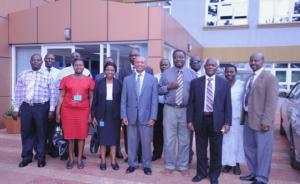Uganda hosts first meeting on strengthening Reproductive Health indicators
Kampala, 10th September 2014:- Uganda hosted the first inter-country meeting on Strengthening the measurement of Reproductive Health (RH) indicators that brought together experts from Kenya, Ghana, Nigeria, Uganda and Zimbabwe. This was to share experiences and update indicators from the national level consultations that were undertaken in Nairobi in 2012. The meeting was focussed on identifying the progress that had been made at country level in trying to add important Family planning and abortion related indicators. The role of monitoring performance and evaluating RH programs was emphasised. Acknowledging that whatever cannot be measured was not done. The meeting also noted that M&E is the weakest part of the implementation of RH programs.
Nigeria as a model country in Strengthening RH indicators presented its findings and paid particular focus on maternal mortality as a result of abortion and the availability of family planning services that are important an important factor of RH.
Speaking at the opening ceremony, the Assistant Commissioner for Reproductive Health in the Ministry of Health (MOH) Dr. Collins Tusingwire praised the country enabling policy environment that strongly encourages family planning and post-abortion care services. He said, the meeting came at the right time when the country is striving to address gaps in RH monitoring and evaluation indicators.
Dr Tusingwire further noted that Ministry of Health has been working closely with WHO to ensure that RH becomes a public health priority in Uganda. “We need better and more capacity building to realise better RH in Uganda”, he said.
Addressing the same meeting, Dr. Akol Zainab, Principal Medical Officer in charge of Family Planning at MOH said that the ministry was committed to working with WHO to find indicators that will be used to monitor RH trends. She said that previously, the Monitoring and Evaluation (M&E) function for RH was inadequately implemented at the ministry. “The maternal and newborn health status in Uganda is very low and we are particular on strengthening the measurement of indicators so that we achieve better RH” she said, adding that the piloting of added RH indicators before inclusion in the Health Management Information System is a good practice.
Dr. Solomon Fisseha from WHO said that a lot of attention should be put on Uganda that has a large population of young people. Presently, 52% of Uganda’s population is 15 years and 78% are under 30 years giving the country the youngest population in the world.
Referring to the recent commitments by government under Vision 2040, Dr Fisseha pointed out that Uganda’s current high fertility level can be effectively dealt with through family planning. A study on harnessing the demographic dividend in Uganda has revealed that the target set for 2040 can not be met unless Family planning is addressed properly.
Dr. Lale Say, Department of Reproductive Health and Research, at WHO headquarters underscored the critical role of M&E in RH noting that that without this component it would be difficult to identify the gaps. But with Reproductive Health M&E it is much easier to identify and address the gaps.
According to the Uganda Demographic and Health Survey, 2010 presently, Uganda’s Fertility Rate is 6.2 live births per woman. The unmet need for family planning is 34%.
The two day meeting also explored possible additional sources of support to implement the pilot phase of the monitoring tools and subsequently, work plans to implement the final phase of the project were agreed on. The project will have to identify national strategies to finalise implementation of planned activities. This meeting was a follow up to one that was held in Nairobi, Kenya in 2012.



